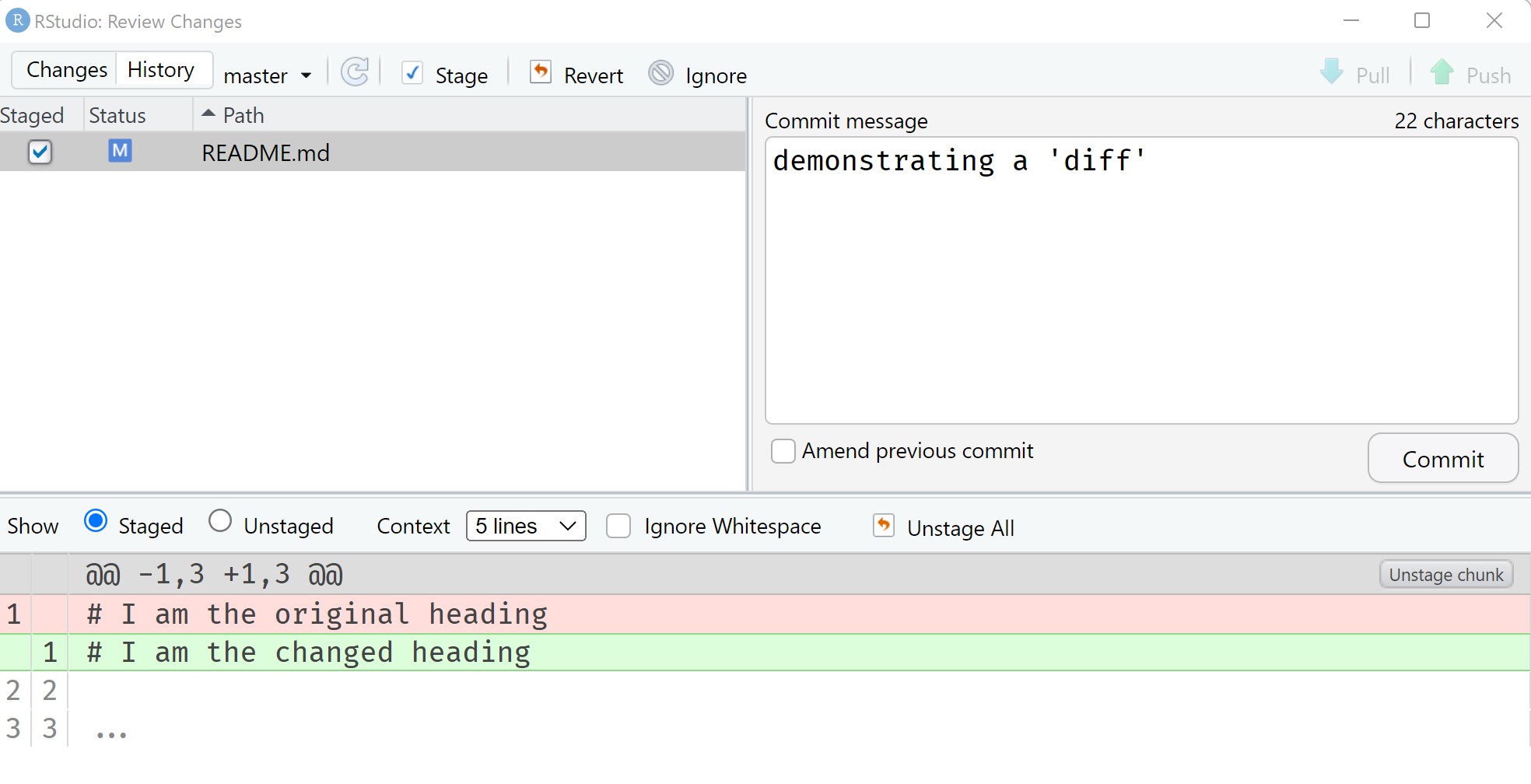flowchart LR A[Alessandro v1] --> B[Alessandro v2] B --> C[Alessandro v3] B --> D[Audrey v1] D --> E[Audrey + Alessandro v4] C --> E
4 Version Control and Collaboration
openstatsware short course: Good Software Engineering Practice for R Packages
August 24, 2025
Disclaimer
Any opinions expressed in this presentation and on the following slides are solely those of the presenter and not necessarily those of their employers.
- Overview, demo, practical
- Can only scratch surface
- More resources on the course website
Photo by Rich @ rhubbardstockfootage on Unsplash
Trade-offs in code development
Working alone:
- No coordination overhead
- No review
- Lack of diversity
- Can slack on documentation
- Fragile long-term maintenance
Working in a team:
- Coordination overhead
- Mutual review of code
- Different approaches
- Forced to document
- More robust long-term maintenance
Key issue:
Manage complexity over time or between people
Photo from Tim Mossholder on Unsplash

No matter how a group is organised, the work of many contributors often needs to be combined into a single set of shared working documents
Managing changes/revisions to these documents is called versioning
Version control systems (VCS)
- Manage different versions of a piece of work
- Compare and merge diverged versions effectively1
- Code is complex system \(\leadsto\) ideal application of VCS
- Compounded by multiple people fiddling with it!
git basics
Enter git

- Created by Linus Torvalds in 2005, for work on Linux kernel
- Essentially a database with snapshots of a monitored repository (directory)
- Optimized to compute line-based changes
- Integrated in RStudio IDE, Visual Studio Code
- De facto standard, and not just in the R world
- Alternatives: mercurial, SVN, …
Photo by Lf Asia & the Archive Team CC BY 3.0
Git commands
- git commands are composed of three parts:
git verb optionsgitinvokes Gitverbis a placeholder for the different actions (such asbranchorcommit, more on that later)optionsis a placeholder for any option possibly required by a certainverb(not always required)
- Hint:
git helpis your friend!
Stage and commit

gitGraph commit commit commit commit commit
- Stage changes for inspection
- allows to inspect proposed changes before locking them in
- Permanently commit changes to git to add them to the project history
\(\leadsto\) Chain of versions with incremental changes
Photo by Felicia Montenegro on Unsplash
Line-based differences - the diff

- Changes in git are line-based
- Additions (green) and deletions (red) between commits are highlighted
Going back in time

- Every commit has a unique hash value
- Can checkout old commit (browse history)
git checkout [commit hash to browse]- Can reset changes
git reset --hard [commit hash to reset to]- Removes need for
my-file_final_v2_2019.R - Time travelling has its dangers…1
Photo by Mila Tovar on Unsplash
Branching

gitGraph commit commit branch feature checkout feature commit commit checkout main commit
- Variations of repository: branches
git branch [my new branch name]- List current branches
git branch- Quick switching between branches
git checkout [branch name]Photo by Mila Tovar on Unsplash
Merging two branches

gitGraph commit commit branch feature checkout feature commit commit checkout main commit merge feature
Photo by Max LaRochelle on Unsplash
Example of gitflow
gitGraph commit tag: "v0.0.1" commit branch feature-1 checkout feature-1 commit commit checkout main branch feature-2 checkout feature-2 commit checkout feature-1 commit checkout main commit tag: "bugfix" merge feature-1 tag: "v0.1.0" checkout feature-2 commit
- gitflow: specific workflow for git repositories
- features developed on branches, then merged into the main one
Version control and collaboration
- git itself is just a command line tool for version control
- git platforms add UI for collaboration1
- GitHub.com de facto standard in R, but alternatives do exist (e.g., GitLab.com)
- git + GitHub
- VCS (git)
- Web hosting of code (GitHub)
- Organisation with issues, discussions (GitHub)
- Automation of checks/test (GitHub)
git platforms
GitHub.com
- Huge number of R packages developed and hosted there:
- 150 million developers and over 400 million repositories on GitHub.com as of June 2025
- See the about GitHub page
- “Social media” for developers / social coding
- Discuss problems, propose changes, publish code
Branches and pull requests
- Branches are a git concept
- Git platforms add the concept of pull request (PR)
- PR is a suggested merge from branch A to B
- Usually from feature A to main
- Allow to preview problems before merge and discuss changes
- Once everyone is happy, a pull request1 can be merged
- Every PR has an associated branch, but not every branch has a PR
- More in the demo!
Automating things with GitHub
- GitHub provides
- Cloud compute
- Scripting framework (GitHub actions)
- Allows task automation, e.g.
- Run unit tests
- Build & host documentation
- Static code analysis (linting)
- Most important actions for R: github.com/r-lib/actions
- Actions can be extremely useful to enforce best-practices and quality
A typical GitHub workflow
sequenceDiagram
participant A as Alessandro
participant GH as GitHub server
participant B as Audrey
A->>A: make change locally & commit to <feature>
A->>GH: push commit
A->>GH: open pull request
GH->>GH: run automated checks
A->>B: request review
B->>B: review code
B->>A: request changes
A->>A: implement changes locally & commit
A->>GH: push commit
GH->>GH: run automated checks
A->>B: request review
B->>B: review code
B->>GH: approve changes, unblocking merge
A->>GH: merge <feature> into <main>
GH->>GH: run automated checks on <main>
B->>GH: pull newest version of <main>
Looks awfully complicated, why?
- Efficient collaboration with novice/untrusted contributors
- Maintainer: automated checks reduce review burden
- Contributor: no need to check manually
- Branching promotes asynchronous work on features
- Full history of the project is preserved - you can always go back
\(\leadsto\) Making collaboration on code scalable
Demo
- Thanks to Audrey for helping me in this demo!
- How do we publish a repository on GitHub?
- How do we add a collaborator on GitHub?
- How does a pull request work?
Practical - collaboration on GitHub
- Work in teams of 3 or 4
- One member of the group can publish the project that we worked on in the previous practicals on their GitHub page
- The same member can then invite the other members as collaborators
- Every member can now:
- Review the project
- Create a new branch
- Propose some edits by opening a PR
- The purpose of this exercise is to explore the collaboration functionality of GitHub - not to produce a perfect package
License information
In the current version, changes were done by (later authors): Daniel Sabanés Bové , Alessandro Gasparini
This work is licensed under the Creative Commons Attribution-ShareAlike 4.0 International License.
The source files are hosted at github.com/openstatsware/shortcourse-iscb2025, which is forked from the original version at github.com/RCONIS/workshop-r-swe-zrh.
Important: to use this work you must provide the name of the creators (initial authors), a link to the material, a link to the license, and indicate if changes were made.